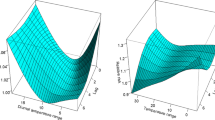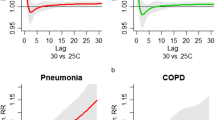Abstract
Sudden temperature changes between neighboring days (T24h) have adverse effects on human health. In this study, we used a time series analysis to evaluate the impact of T24h on the number of hospital admissions for chronic obstructive pulmonary disease (COPD) from 2009 to 2012 in Changchun (the capital of Northeast China’s Jilin province). We performed the analysis in a generalized additive model (GAM), and the controlling factors included long-term trends, day of the week effect, and the selected weather elements. We divided the entire study group into two gender subgroups (males and females) and two age subgroups (aged < 65 years and aged ≥ 65 years). T24h showed the greatest effect on the entire study group at lag 3 days. In particular, the greatest effect of T24h on females (males) occurred at lag 1 day (lag 3 days); the greatest effect of T24h on the aged ≥ 65 years (aged < 65 years) occurred at lag 1 day (lag 6 days). This indicates that temperature changes between neighboring days have a relatively more acute effect on the elderly and the females than on the younger people and the males. When T24h is less than zero, the highest RR of the number of hospital admissions for COPD occurred at lag 4 days during the warm season (1.025, 95% CI: 0.981, 1.069) and lag 3 days during the cold season (1.019, 95% CI: 0.988, 1.051). When T24h is greater than zero, the highest RR of the number of hospital admissions for COPD occurred at lag 6 days during the warm season (1.026, 95% CI: 0.977, 1.077) and lag 5 days during the cold season (1.021, 95% CI: 0.986, 1.057). The results of this study could be provided to local health authorities as scientific guidelines for controlling and preventing COPD in Changchun, China.




Similar content being viewed by others
References
Basu R (2009) High ambient temperature and mortality: a review of epidemiologic studies from 2001 to 2008. Environ Health 8:40–52
Carder M, McNamee R, Beverland I, Elton R, Cohen GR, Boyd J, Agius RM (2005) The lagged effect of cold temperature and wind chill on cardiorespiratory mortality in Scotland. Occup Environ Med 62:702–710
Carmona R, Zhu R, Xu Z, Xu X, Wang X, Li K (2014) Mortality attributable to extreme temperatures in Spain: a comparative analysis by city. Environ Int 91:22–28
Cheng J, Zhu R, Xu ZW, Wu JJ, Wang X (2016) Li KS (2016) Impact of temperature variation between adjacent days on childhood hand, foot and mouth disease during April and July in urban and rural Hefei, China. Int J Biometeorol 60:883–890
Cheng J, Zhu R, Xu ZW, Xu XQ, Wang X, Li KS, Su H (2014) Temperature variation between neighbouring days and mortality: a distributed lag non-linear analysis. Int J Public Health 59:923–931
Diaz J, Garcia R, Velazquez de Castro F, Hernandez E, Lopez C (2002) Effects of extremely hot days on people older than 65 years in Seville (Spain) from 1986 to 1997. Int J Biometeorol 46:145–149
Ding Z, Li LJ, Xin LY, Pi FH, Dong WY, Wen Y, Au WW, Zhang QY (2016) High diurnal temperature range and mortality: effect modification by individual characteristics and mortality causes in a case-only analysis. Sci Total Environ 544:627–634
Frascarolo P, Schutz Y, Jequier E (1990) Decreased thermal conductance during the luteal phase of the menstrual cycle in women. J Appl Physiol 69:2029–2033
Gasparrini A, Guo Y, Hashizume M, Lavigne E, Zanobetti A, Schwartz J (2015) Mortality risk attributable to high and low ambient temperature: a multicountry observational study. Lancet 386:369–375
Graudenz GS, Landgraf RG, Jancar S, Tribess A, Fonseca SG, Fae KC, Kalil J (2006) The role of allergic rhinitis in nasal responses to sudden temperature changes. J Allergy Clin Immunol 118(5):1126–1132
Guo Y, Barnett AG, YW PX, Ye X, Huang C, Tong S (2011) A large change in temperature between neighbouring days increases the risk of mortality. PLoS One 6(2):e16511
Guo Y, Li SS, Zhang YS, Armstrong B, Jaakkola JJK, Tong SL, Pan XC (2013) Extremely cold and hot temperatures increase the risk of ischaemic heart disease mortality: Epidemiological evidence from China. Heart 99(3):195–203
Goodman PG, Dockery DW, Clancy L (2004) Cause-specific mortality and the extended effects of particulate pollution and temperature exposure. Environ Health Perspect 112:179–185
Hajat S, Kovats RS, Lachowycz K (2007) Heat-related and cold-related deaths in England and Wales: who is at risk? Occup Environ Med 64:93–100
Ikram M, Yan ZJ, Liu Y, Qu WH (2015) Seasonal effects of temperature fluctuations on air quality and respiratory disease: a study in Beijing. Nat Hazards 79(2):833–853
Ishigami A, Hajat S, Kovats RS, Bisanti L, Rognoni M, Russo A, Paldy A (2008) An ecological time-series study of heat-related mortality in three European cities. Environ Health 7:5–11
Kenney WL, Hodgson JL (1987) Heat tolerance, thermoregulation and ageing. Sports Med 4:446–456
Liang WM, Liu WP, Kuo HW (2009) Diurnal temperature range and emergency room admissions for chronic obstructive pulmonary disease in Taiwan. Int J Biometeorol 53(1):17–23
Lin HL, Zhang YH, Xu YJ, Xu XJ, Liu T, Luo Y, Xiao JP, Wu W, Ma WJ (2013) Temperature changes between neighboring days and mortality in summer: a distributed lag non-linear time series analysis. PLoS One 8(6):e66403
Liu B, Responses of cerebral stroke and cerebral vascular accident to weather change and forecasting models. Lanzhou University, Lanzhou, Gansu, China, 2014.(In Chinese)
Ma Y, Zhao Y, Zhou J, Jiang Y, Yang S, Yu Z (2018) The relationship between diurnal temperature range and COPD hospital admissions in Changchun, China. Environ Sci Pollut Res 25(18):17942–17949
Ma W, Wang L, Lin H, Liu T, Zhang Y, Rutherford S, Luo Y, Zeng WL, Zhang YW, Wang XF, Gu X, Chu C, Xiao JP, Zhou MG (2015) The temperature-mortality relationship in China: an analysis from 66 Chinese communities. Environ Res 137:72–77
Ostro B, Rauch S, Green R, Malig B, Basu R (2010) The effects of temperature and use of air conditioning on hospitalizations. Am J Epidemiol 172:1053–1061
Plavcova E, Kysely J (2010) Relationships between sudden weather changes in summer and mortality in the Czech Republic, 1986–2005. Int J Biometeorol 54:539–551
Song GX, Chen GH, Jiang LL, Zhang YH, Zhao NQ, Chen BH, Kan HD (2008) Diurnal temperature range as a novel risk factor for COPD death. Respirology 13(7):1066–1069
Stafoggia M, Forastiere F, Agostini D, Biggeri A, Bisanti L, Cadum E, Caranci N, de Donato F, De Lisio S, De Maria M, Michelozzi P, Miglio R, Pandolfi P, Picciotto S, Rognoni M, Russo A, Scarnato C, Perucci CA (2006) Vulnerability to heat-related mortality: a multicity, population-based, case crossover analysis. Epidemiology 17:315–323
Sun SZ, Laden F, Hart JE, Qiu H, Wang Y, Wong CM, Lee RSY, Tian LW (2018) Seasonal temperature variability and emergency hospital admissions for respiratory diseases: a population-based cohort study. Thorax 73(10):951–958
Schneider A, Schuh A, Maetzel FK, Ruckerl R, Breitner S, Peters A (2008) Weather-induced ischemia and arrhythmia in patients undergoing cardiac rehabilitation: another difference between men and women. Int J Biometeorol 52:535–547
Vaneckova P, Beggs PJ, de Dear RJ, McCracken KWJ (2008) Effect of temperature on mortality during the six warmer months in Sydney, Australia, between 1993 and 2004. Environ Res 108:361–369
Yang J, Ou CQ, Ding Y, Zhou YX, Chen PY (2012) Daily temperature and mortality: a study of distributed lag non-linear effect and effect modification in Guangzhou. Environ Health 11(63):1–9
Zhan ZY, Zhao Y, Pang SJ, Zhong SP, Wu C, Ding Z (2017) Temperature change between neighbouring days and mortality in United States: a nationwide study. Sci Total Environ 2017(584-587):1152–1161
Zhang YQ, Yu CH, Bao JZ, Li XD (2017) Impact of temperature variation on mortality: an observational study from 12 counties across Hubei Province in China. Sci Total Environ 587-588:196–203
Zhou X, Zhao A, Meng X, Chen R, Kuang X, Duan X, Kan H (2014) Acute effects of diurnal temperature range on mortality in 8 Chinese cities. Sci. Total Environ 493:92–97
Zhou XF, Yu SY, Ruan XN, Yang LM, Geng FH, Zhou Y, Qiu H, Wu K, Song ZW, Wang XN, Rui XY, Zhong HY, Bi WJ, Peng L, Yang DD, Sun Q (2015) Effect of meteorological factors on outpatient visits in patients with chronic obstructive pulmonary disease. J Environ Occup Med 08:711–716
Acknowledgments
We would like to thank the support from Professional Services for Meteorology, Environment and Public Health of the National Scientific Data Sharing Platform for Population and Health. This work is supported by National Natural Science Foundation of China (Grants Nos. 41975141 and 41475095).
Author information
Authors and Affiliations
Corresponding author
Ethics declarations
Conflict of interest
The authors declare that they have no conflict of interest.
Additional information
Responsible editor: Philippe Garrigues
Publisher’s note
Springer Nature remains neutral with regard to jurisdictional claims in published maps and institutional affiliations.
Electronic supplementary material
ESM 1
(DOCX 55 kb)
Rights and permissions
About this article
Cite this article
Ma, Y., Jiao, H., Zhang, Y. et al. Impact of temperature changes between neighboring days on COPD in a city in Northeast China. Environ Sci Pollut Res 27, 4849–4857 (2020). https://doi.org/10.1007/s11356-019-07313-1
Received:
Accepted:
Published:
Issue Date:
DOI: https://doi.org/10.1007/s11356-019-07313-1




